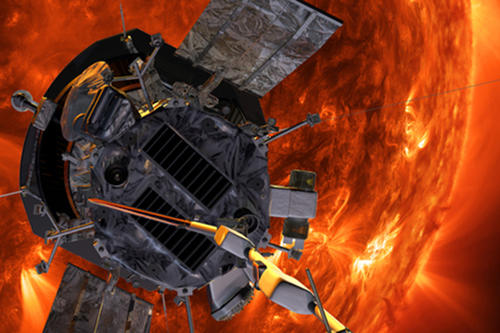
In December 2019 physicists wowed the solar physics world with the first results from NASA’s Parker Solar Probe spacecraft, which has swooped closer to the sun than any other human-made object—just half Mercury’s distance. Launched in August 2018, the probe seeks to solve the two biggest mysteries of the solar corona.
First mystery: What mechanism heats the corona to more than 100 times the already toasty temperature—10,000 degrees Fahrenheit—of the solar surface?
“Whatever heats the corona has to be electric and magnetic fields. That’s all there is,” says University of Minnesota physicist Keith Goetz, the principal investigator for the University’s Parker Solar Probe team.
Second mystery: What is the coronal dynamo that creates the “solar wind” by accelerating subatomic particles from the sun’s surface to speeds up to a million miles per hour and spewing them out in a 3-D stream that bathes the solar system.
“The solar wind can energize particles trapped in Earth’s magnetic field, leading to beautiful auroras. But it can also lead to damage to the electrical grid and telecommunications, and can even pose a danger to satellites and astronauts in orbit,” says Goetz.
A deeper understanding of how the sun creates the solar wind will help scientists predict events and minimize damage.
When magnetic fields take a hairpin turn
When the spacecraft picked up especially powerful vibrations in the sun’s magnetic fields—like vibrations in gigantic harp strings— the solar wind sped up by 300,000 miles per hour in just seconds. The strongest waves also sharply reversed the direction of the magnetic field, contorting it into an S-shaped pattern the scientists dubbed a switchback, after the hairpin turns on a steep mountain road.
Scientists are excited about these events because they believe they hint at how the energy that heats the corona is transported up from the solar surface.
Coronal holes
Bursts of solar wind faster than a million miles per hour have been detected escaping from cooler regions of the corona—coronal “holes”—near the sun’s polar regions. Now, the Parker Solar Probe has caught slower gusts issuing from coronal holes nearer the solar equator.
Earth-based instruments could not have sorted out the origins of the fast and slow particles because they intermingle in transit and arrive all jumbled up. But with the sun-grazing orbiter, scientists can observe the various species of solar wind at their birth.
- Categories:
- Science and Technology





